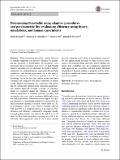Determining thresholds using adaptive procedures and psychometric fits: evaluating efficiency using theory, simulations, and human experiments
Author(s)
Karmali, Faisal; Yi, Yongwoo; Merfeld, Daniel M.; Chaudhuri, Shomesh Ernesto
Download221_2015_Article_4501.pdf (849.0Kb)
PUBLISHER_POLICY
Publisher Policy
Article is made available in accordance with the publisher's policy and may be subject to US copyright law. Please refer to the publisher's site for terms of use.
Terms of use
Metadata
Show full item recordAbstract
When measuring thresholds, careful selection of stimulus amplitude can increase efficiency by increasing the precision of psychometric fit parameters (e.g., decreasing the fit parameter error bars). To find efficient adaptive algorithms for psychometric threshold (“sigma”) estimation, we combined analytic approaches, Monte Carlo simulations, and human experiments for a one-interval, binary forced-choice, direction-recognition task. To our knowledge, this is the first time analytic results have been combined and compared with either simulation or human results. Human performance was consistent with theory and not significantly different from simulation predictions. Our analytic approach provides a bound on efficiency, which we compared against the efficiency of standard staircase algorithms, a modified staircase algorithm with asymmetric step sizes, and a maximum likelihood estimation (MLE) procedure. Simulation results suggest that optimal efficiency at determining threshold is provided by the MLE procedure targeting a fraction correct level of 0.92, an asymmetric 4-down, 1-up staircase targeting between 0.86 and 0.92 or a standard 6-down, 1-up staircase. Psychometric test efficiency, computed by comparing simulation and analytic results, was between 41 and 58 % for 50 trials for these three algorithms, reaching up to 84 % for 200 trials. These approaches were 13–21 % more efficient than the commonly used 3-down, 1-up symmetric staircase. We also applied recent advances to reduce accuracy errors using a bias-reduced fitting approach. Taken together, the results lend confidence that the assumptions underlying each approach are reasonable and that human threshold forced-choice decision making is modeled well by detection theory models and mimics simulations based on detection theory models.
Date issued
2015-12Department
Massachusetts Institute of Technology. Department of Electrical Engineering and Computer ScienceJournal
Experimental Brain Research
Publisher
Springer Berlin Heidelberg
Citation
Karmali, Faisal et al. “Determining Thresholds Using Adaptive Procedures and Psychometric Fits: Evaluating Efficiency Using Theory, Simulations, and Human Experiments.” Experimental Brain Research 234.3 (2016): 773–789.
Version: Author's final manuscript
ISSN
0014-4819
1432-1106